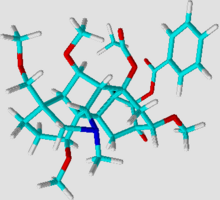Delphinine
Topic: Chemistry
 From HandWiki - Reading time: 4 min
From HandWiki - Reading time: 4 min

| |

| |
| Names | |
|---|---|
| Other names
8-(Acetyloxy)-13-hydroxy-1,6,16-trimethoxy-4-(methoxymethyl)-20-methylaconitan-14-yl benzoate
| |
| Identifiers | |
3D model (JSmol)
|
|
| ChemSpider | |
PubChem CID
|
|
| UNII | |
| |
| |
| Properties | |
| C33H45NO9 | |
| Molar mass | 599.712 |
| Appearance | colorless solid |
| Melting point | 197 to 199 °C (387 to 390 °F; 470 to 472 K) |
| Hazards | |
| Main hazards | Toxic |
Except where otherwise noted, data are given for materials in their standard state (at 25 °C [77 °F], 100 kPa). | |
| Infobox references | |
Delphinine is a toxic diterpenoid alkaloid found in plants from the Delphinium (larkspur) and Atragene (a clematis) genera, both in the family Ranunculaceae.[1] Delphinine is the principal alkaloid found in Delphinium staphisagria seeds – at one time, under the name stavesacre, a very well known herbal treatment for body lice.[2] It is related in structure and has similar effects to aconitine, acting as an allosteric modulator of voltage gated sodium channels,[3] and producing low blood pressure, slowed heart rate and abnormal heart rhythms. These effects make it highly poisonous (-1">50 1.5–3.0 mg/kg in rabbit and dog; frogs are ~10x more susceptible).[4] While it has been used in some alternative medicines (e.g. in herbal medicine[5][6]), most of the medical community does not recommend using it due to its extreme toxicity.
Isolation
One of the earliest reports of the isolation of delphinine, from D. staphisagria, was that of the French chemists Lassaigne and Feneulle, in 1819.[7] A less antique and more accessible report is that of the USDA chemist L. N. Markwood, who also briefly reviewed the earlier isolation work.[8] Notably, these early isolations were carried out without the aid of chromatography, since delphinine crystallizes readily from a petroleum ether extract after the typical acid-base cycling used in traditional plant alkaloid-extraction methods.[9]
Chemistry
Despite the relative ease of isolation and early discovery of delphinine, its molecular structure was not established in its currently accepted form until the early 1970s. At that time, Wiesner's research group corrected the stereochemistry of the methoxy group at C-1 from the β- to the α- configuration.[10][11] Thus, any drawing of the delphinine molecule appearing before 1971–1972 is likely to show the incorrect stereochemistry at C-1.
Pharmacology
As a result of its early discovery and isolation in crystalline form (then considered a criterion of purity), the pharmacological properties of delphinine were extensively investigated in the 19th Century, despite the fact that its molecular structure was unknown. It is likely that some of these investigations were carried out with impure drug and should be interpreted with caution. References to and commentary on these early studies may be found in the review by Benn and Jacyno.[4] More recent studies focused on the cardiovascular toxicity of delphinine.[12][13]
In general, the pharmacology of delphinine seems to resemble that of aconitine, although the acute toxicity of delphinine appears to be lower than that of aconitine in test animals.[4]
References
- ↑ Phytochemical Dictionary. London: Taylor & Francis. 1993. p. 148.
- ↑ "A Modern Herbal | Stavesacre". http://www.botanical.com/botanical/mgmh/s/stavas90.html.
- ↑ "Aconitum and Delphinium sp. alkaloids as antagonist modulators of voltage-gated Na+ channels. AM1/DFT electronic structure investigations and QSAR studies". Computational Biology and Chemistry 32 (2): 88–101. April 2008. doi:10.1016/j.compbiolchem.2007.10.003. PMID 18201930.
- ↑ 4.0 4.1 4.2 "Chapter 4". The Alkaloids: Chemical and Biological Perspectives (New York: Wiley) 1: 153–210. 1983.
- ↑ "Certain norditerpenoid alkaloids and their cardiovascular action". Journal of Natural Products 61 (6): 743–8. June 1998. doi:10.1021/np970499j. PMID 9644057.
- ↑ "Alkaloids from Delphinium staphisagria". Journal of Natural Products 63 (8): 1136–9. August 2000. doi:10.1021/np990453l. PMID 10978212.
- ↑ "Analyse de la staphisaigre.". Ann. Chim. Phys.. Série 2 12: 358–71. 1819.
- ↑ "Isolation of the oil and alkaloids of stavesacre seed.(Delphinium staphisagria).". Journal of the American Pharmaceutical Association 16 (10): 928–32. October 1927. doi:10.1002/jps.3080161006.
- ↑ "DELPHININE". Journal of Biological Chemistry 127 (2): 361–6. February 1939. doi:10.1016/S0021-9258(18)73787-3. https://www.jbc.org/content/127/2/361.short.
- ↑ "The diterpene alkaloids: the structure and stereochemistry of heteratisine.". Tetrahedron 29 (21): 3297–308. January 1973. doi:10.1016/S0040-4020(01)93482-9.
- ↑ "Recent developments in diterpenoid alkaloids chemistry". Alkaloids. 2. London: The Chemical Society. January 1972. pp. 247–258 (254–255). doi:10.1039/9781847555588-00247. ISBN 978-0-85186-267-5.
- ↑ "The effect of diphenylhydantoin (Dilantin) sodium on atrial flutter and fibrillation provoked by focal application of a conitine or delphinine". American Heart Journal 60 (6): 936–47. December 1960. doi:10.1016/0002-8703(60)90125-3. PMID 13747515.
- ↑ Extrasystoles and Allied Arrhythmias (2nd ed.). London: Heinemann. 1973.
 |
 KSF
KSF